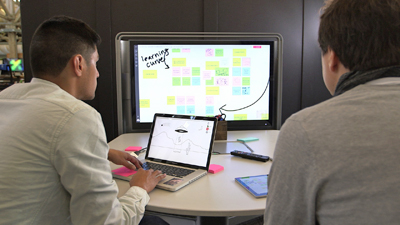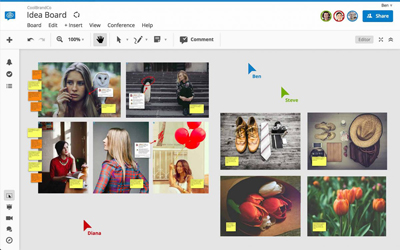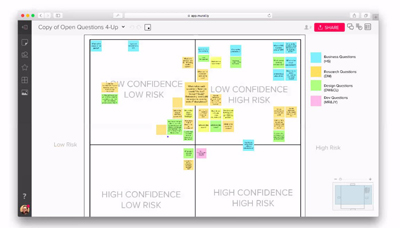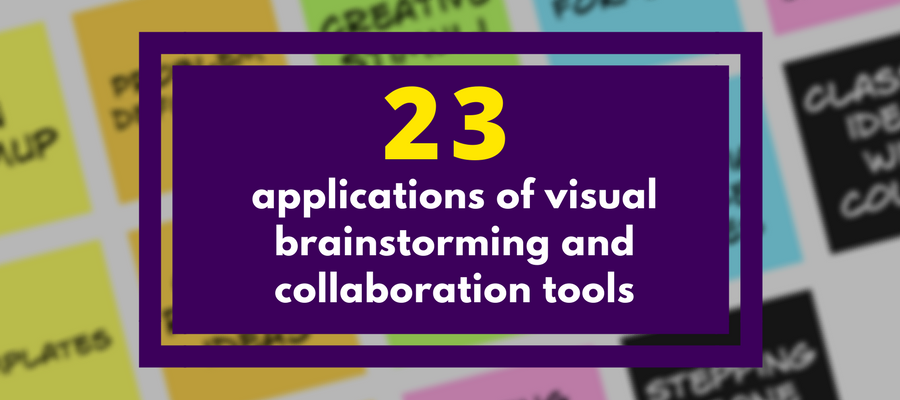Visual brainstorming and collaboration applications are wonderful tools for distributed teams to ideate and develop ideas. But a recent review of developer websites shows that customers are using these tools for far more than just noodling new ideas and solutions.
What makes these tools unique is that they provide a wide-open canvas where you can place ideas as sticky notes or nodes, and then move, group and manipulate them at will. Many of them also enable you to insert images, links, notes, connector lines and other embellishments to add meaning and context to your ideas.
Examples of these tools include Mural.ly, ConceptBoard, Stormboard and GroupMap. Not included in this genre are tools that provide a simple, shared whiteboard for sketching, dedicated web-based diagramming tools like LucidChart or whiteboard-sharing applications like Groupboard and SketchTogether.
Here are some of the real-world business applications where visual brainstorming and collaboration tools are being used today to help distributed teams work more efficiently and effectively:
Basic brainstorming functionality
 Distributed team brainstorming: This is the base-level functionality of these tools. Anyone who has access to a shared team space can add ideas to it, one per sticky note, shape or node. All ideas are free-floating – that is, unconnected from other ideas.
Distributed team brainstorming: This is the base-level functionality of these tools. Anyone who has access to a shared team space can add ideas to it, one per sticky note, shape or node. All ideas are free-floating – that is, unconnected from other ideas.
Organize, share and develop ideas: After team members have finished adding their ideas to the shared workspace, the session facilitator switches their focus to making sense of what they have gathered. That’s why these tools enable to drag and drop ideas into groupings; some of them even enable you to create enclosed areas or “containers” for specific groups of ideas that the team agrees are related.
Evaluate ideas: Most visual brainstorming and collaboration tools enable team members to evaluate or vote for ideas they like. Dot voting is common in offline, face-to-face brainstorming environments. This metaphor is used by several developers to enable teams to identify those ideas they believe have the greatest value to the organization, department or team. Grouping of ideas is another mechanism that teams can use to separate those ideas with potential from those that do not.
We know of one company that uses the unlimited canvas of its visual brainstorming and collaboration tool to work its way through multiple “flights” of ideas. In other words, out of 100 ideas, the team may identify 25 that are worthy of additional attention. These are grouped together on-screen, and are moved to a new section of the workspace. There, the team can turn its focus to idea combination and improvement, and further evaluation criteria.
Templates: Within these web-based applications, templates appear on a background layer and provide structure to the team’s thinking exercises and models. Examples of such thinking models include SWOT, 6 Thinking Hats, Perceptual Maps, Stakeholder Maps, Risk Maps, Mind Maps, and Lean Business Canvas.
Advanced business applications
Make better informed decisions: Teams can use sticky notes or idea nodes to identify decision criteria, explore pros and cons and view the decision at hand from multiple perspectives.
Share creative concepts/solicit feedback: For marketing teams that work with creative visuals,such as advertising, collateral pieces, direct mailers and infographics, this type of shared environment is the perfect place to kick around ideas and come to consensus on a creative approach. Team members can also upload comp images of creative concepts, and other team members can provide feedback in the form of sticky notes or notes attached to the image. Here’s one example from an actual creative team.
Conflict and change management: Teams can map out issues and concerns and can also brainstorm potential solutions. In addition, you can use this collaborative environment to perform a force field analysis, visualizing the hindering and driving forces that are influencing the desired change and helping team members better understand how to implement change and get buy-in from the organization’s employees.
Strategic planning: Strategy is about devising a way you believe you’ll best overcome challenges to reach a desired position. As this article from the Mural blog points out, “building strategy is a creative endeavor and a group activity. The strategy blueprint allows you to explore options as a team. Try alternatives, cross items off, rework ideas, and start over again. Design your strategy and get agreement on it.” It is both a collaborative and a creative activity. A visual collaboration canvas is the perfect medium for doing this type of business planning.
 Facilitate design thinking: Design thinking requires a lot of visual thinking to share and clarify ideas. Visual collaboration tools enable this process through sticky notes, images and illustrations, which can easily be added to the workspace. Design thinking also requires team members to quickly create crude prototypes, get feedback by a target audience or constituents, and then quickly and iteratively improve the prototype. Not only is a visual collaboration tool useful for ideation and prototyping, it also makes it easier for team members to explain their prototypes to the people from whom they need feedback.
Facilitate design thinking: Design thinking requires a lot of visual thinking to share and clarify ideas. Visual collaboration tools enable this process through sticky notes, images and illustrations, which can easily be added to the workspace. Design thinking also requires team members to quickly create crude prototypes, get feedback by a target audience or constituents, and then quickly and iteratively improve the prototype. Not only is a visual collaboration tool useful for ideation and prototyping, it also makes it easier for team members to explain their prototypes to the people from whom they need feedback.
Mapping customer needs/persona development: These two related concepts are critically important to content marketers, who need to “get inside the heads” of their prospective customers to understand what motivates them and the challenges they face. These attributes can easily be mapped out with in a visual workspace.
Backcasting: This retro thinking technique starts with an ideal future vision. Then, as the name suggests, you map the steps needed to work your way backwards to the present day. The process is simple: place your ideal future state on the right and work to the left on a timeline. Ask yourself: What tasks would need to take place for each step to be completed? Add as many steps as you need to keep working backward to the present day.
Gather and accumulate bits of research over time in a board: When you look at a collaborative brainstorming tool like Mural, ConceptBoard or StormBoard, you may make the assumption that it can only be used for real-time remote brainstorming, where the entire team is contributing ideas at the same time, or for asynchronous brainstorming, where team members are logging in to the shared workspace as they have time available and are adding their ideas. But you’d be wrong. One of the other applications of these tools is to enable teams to conduct research and add their findings to a shared workspace. This process can span days or weeks, a collection that is gradually nurtured into existence. Team members can also pose questions and ask for clarification on their colleagues’ contributions, making it a truly interactive research space.
Map user experiences/UX design: User experience design is a proven method for empathizing with customers and seeing products from the outside in – as they see them. Understanding your customer’s experience is the first step in creating solutions that provide real value for them. Diagramming this process in a team-based visual environment frequently often reveals opportunities for refinement, simplification, clarity and growth.
 Storymapping/customer journey map: User story mapping is an Agile thinking technique that enables teams to define mini-stories for customer goals, yet keep them connected to the larger narrative of the project. Normally, teams do this on a large whiteboard, which enables them to display the mini-stories and see the overall story at the same time. The ability to do this in a shared web environment is a big advantage for distributed teams.
Storymapping/customer journey map: User story mapping is an Agile thinking technique that enables teams to define mini-stories for customer goals, yet keep them connected to the larger narrative of the project. Normally, teams do this on a large whiteboard, which enables them to display the mini-stories and see the overall story at the same time. The ability to do this in a shared web environment is a big advantage for distributed teams.
Product and service design: Customer experience is a big deal today, as firms in nearly every industry explore and implement better ways and processes to keep customers engaged and happy. Mapping your customer’s experience helps you to see things through their eyes and to spot opportunities for growth and for new product and service development. A web-based brainstorming and collaboration tool enables teams to view both the forest and the trees – an individual touch point, such as a customer e-newsletter, and also be able to view it in the larger context of all of the organization’s customer interactions.
Moodboarding for creative teams: A web-based brainstorming and collaboration tool enables distributed creative teams to contribute collaborate around large quantities of ideas, inspirations and creative “raw” materials quickly and at scale. They can not only use it to consider a wider range of creative options internally, but also to present their thinking to clients.
Ad agencies can use this shared visual environment to create moodboards that represent a specific art direction envisioned for a client, or images that represent the brand’s target audience. It’s also very useful for collaborating with internal or external designers. Rather than describing what he or she is looking for, the art director can SHOW them – visually.
Event planning: Planning an event is often a multi-faceted affair that requires you to track and manage a myriad of details – from a list of invitees and presenters to audio-visual arrangements and meal planning, it can be a huge project. A visual brainstorming and collaboration environment gives you a powerful, flexible canvas where a meeting manager can capture, organize and manage all of these details. He or she can also use the visual environment to collaborate with vendors, manage subcontractors and other internal and external people who are part of the event team.
New product development: Developing new and improved products is the lifeblood of many businesses. Product managers need to be able to capture current customer needs and richly envision future possibilities and opportunities. Vendors, marketing representatives and others need to be involved in the project early to increase buy-in and reach consensus on the best course of action.
Assumptions mapping: This is an exercise in which a cross-functional team can unpack risky assumptions about a new product or service. It considers three perspectives:
- Is this idea something that customers need, or which would solve a problem that they’re sufficiently aware of to want a solution to it?
- Should we develop this product (Will it create a sustainable revenue stream? Is it a good fit for the company?)
- Can we develop this product (do we have the capabilities and resources to do so)?
In each case, different teams within the organization bring their perspectives to this 3-step process, which results in a much more accurate picture of a potential new product and its risks, requirements and upside potential.
Questionstorming (problem definition): There are many ways to look at any problem. That’s why teams need to invest time and effort defining the scope of the problem they want to solve – BEFORE they start brainstorming. Creativity expert and author Scott Berkun calls this process questionstorming, and it consists of 4 steps:
- Draft a challenge statement that briefly describes the problem you’re trying to solve.
- Challenge the challenge – have team members capture as many questions as possible about the problem statement (examples include clarification and assumptions-based questions).
- Cluster questions and discuss. Focus on the most important themes and collections of questions.
- Re-write the challenge, based on the questions and the group conversation.
Design sprints: This is a concept from AGILE development. Design sprints are concentrated bursts of team collaboration; teams meet (in person or virtually) for days or a week to focus on a specific design challenge. Design sprints are intense, but are usually very productive. Visual brainstorming and collaboration tools enable distributed teams to engage in design sprints very efficiently. Some applications integrate live chat capabilities and comments on ideas, enabling team members to ask questions, share opinions and reach consensus on key design elements.
Storyboard your presentation: In movie production, a storyboard consists of a series of sketches that depict the significant changes of action and scene in a film. For a presentation, you can use storyboards to plan the sequence and flow of ideas you plan to present. Organizing these ideas in a virtual brainstorming and collaboration environment gives you the ability to drag and drop your ideas into a sequence that makes the most sense to you. You can even create “branches” off of your presentation flow to explore non-linear opportunities for storytelling.
A simple team message board: Weekly team meetings, internal newsletters and social intranets are some of the ways organizations use to keep everyone on the same page regarding the status of projects and other key initiatives. Another powerful way to do this is by creating a shared visual canvas, where team members can share images, drawings, documents and more. This article from the Mural.ly blog explains how to set one up in your firm.


Leave a Reply